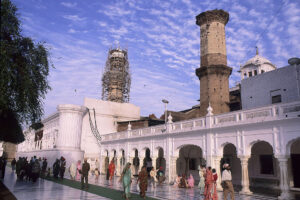Kaj Halberg - writer & photographer
Travels ‐ Landscapes ‐ Wildlife ‐ People
Sikhism


Guru Nanak was convinced that everybody is born equal, and, consequently, he was very much opposed to the Hindu caste system, which claims that you are born into one of four castes. This caste system is described in detail on the page Religion: Hinduism.
Originally, leaders of the Sikhs were the so-called Gurus – ten in succession. In principle, the sacred book of Sikhism, Adi Granth, is the eleventh, eternal Guru. All Sikh temples have a copy of these sacred scripts, from which passages are recited daily.
Today, this pond is square, measuring 165 m across. For Sikhs, a bath in this pond equals a pilgrimage of Hindus to their 68 most sacred locations. Around the pond, a settlement named Amritsar was founded, which, over the years, became a large city.
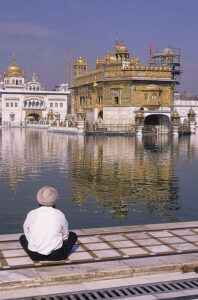
In 1699, Gobind Singh instigated the Khalsa, a brotherhood of warriors, whose duty it is to protect the innocent from any form of religious persecution. He introduced the rule of the five Kakkers, which all members of the brotherhood must follow: Kesha (hair and beard are never to be cut), Kangha (always bring a comb), Kachha (wear shorts), Kara (wear a metal ring around your wrist), and, finally, Kirtipan (always be armed with a sword or a knife to defend the innocent).
By obeying these rules, male members of the Khalsa Brotherhood are easily recognized by their long, full beard and their turban, which is meticulously arranged in a special style, hiding the very long hair, which, like the beard, is never cut. The beard is often tightly tied, using a net or a length of cloth.
All men, who join the Khalsa Brotherhood, take the name of Singh (‘Lion’), originally a high caste name from Rajasthan, whereas the women are called Kaur (’Princess’). Khalsa members must also observe four other fundamental rules: do not smoke; do not drink alcohol; eat only ’pure’ food (no meat, fish, or eggs); marriage must take place within the brotherhood.
Sikhs, who do not join the Khalsa Brotherhood, are called Sahajdhari Sikhs. They revere the Sikh teachings, but do not undergo the initiation.
There are about 27 million Sikhs worldwide. Despite the fact that they only number about 22 million in India, they form a distinct ethnic group in the country, known as skilled traders and technicians. They are also often employed as autorickshaw or bus drivers.
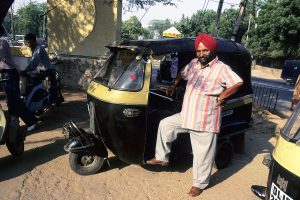
Baba Deep Singh (1682-1757) was a scholar, who is revered among Sikhs as one of the most hallowed martyrs in Sikhism. He felt responsible for letting the Afghans desecrate the shrine. He left his retirement and urged people to join him on a crusade against the Afghans, and more than five thousand Sikhs, armed with hatchets, swords, and spears, accompanied him.
The Sikhs fought heroically against the Afghans, but in the ensuing battle, Baba Deep Singh was killed. According to one legend, his head was cut off 6 km from the Hari Mandir – but, holding his head in one hand, the other hand continued fighting. Before the battle, Baba Deep Singh had declared that he would only die at the sacred pond Amrit Sarovar. Still holding his head in his hand, he managed to reach the pond, where he fell to the ground, dead.
Another legend has it that he was mortally wounded with a blow to the neck, but not completely decapitated. Supporting his head with his left hand, he made his way through the Afghan forces, killing them left and right with mighty strokes of his khanda (double-edged sword). When he finally reached the pond, he drew his last breath. (Source: en.wikipedia.org/wiki/Baba_Deep_Singh)
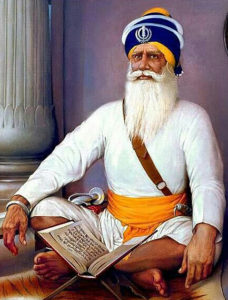
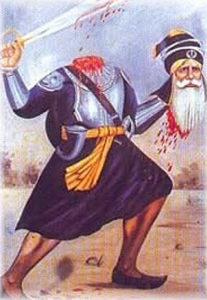
Above the entrance, the triangular orange Sikh banner, Nishan Sahib, is fluttering. The temple is guarded by stern, but friendly Sikhs, who wear a blue, black, or saffron-coloured turban, and by proud Nihang (’Crocodile’) Sikhs, armed with long spears. These Nihangs are followers of the militant Guru Gobind Singh Ji. They wear long, blue robes and pointed turbans, to which a Sikh emblem is attached.
An 8-metre wide walkway, Parikrama, has been constructed around the pond, consisting of polished marble slabs, adorned with beautiful patterns. Pilgrims bathe in the sacred pond, in which hundreds of large carps live, occasionally emerging to gulp a mouthful of air. These carps assist in keeping the water clean.
In the centre of the pond is the sanctum sanctorum, Hari Mandir, a temple in three stories. As in all Sikh temples, the roof is onion- or lotus-shaped, the roof and parts of the marble walls covered in pure gold plates, all together weighing more than 100 kilos. This gold-covering has given rise to the popular name, ‘The Golden Temple’. The gold was donated by Maharaja Ranjit Singh – the person who united Punjab. Those parts of the walls, which are not covered by gold plates, are beautifully adorned with inlaid precious stones.
A 62-metre long marble bridge, leading from the edge of the pond to the temple, is densely packed with pilgrims, each bringing an offering, prasad, comprising ghee (clarified butter), flour, and sugar.
On the lower floor of the temple, priests sing and play music from dawn to dusk, and often in the evening as well. On the second floor, the sacred book Adi Grant is kept during daylight hours, priests continually reciting from its c. 3,500 hymns. Pilgrims place offerings of money or flowers near the sacred script. In the evening, Adi Grant is carried to a building with golden domes, Akhal Takht, erected in 1609 as the religious parliament of the Sikhs.
A temple for Baba Deep Singh – the warrior who continued fighting against the Afghans without his head – is found at the southern end of the Parikrama. Inside this temple is a painting of him, standing with his head in his hands.
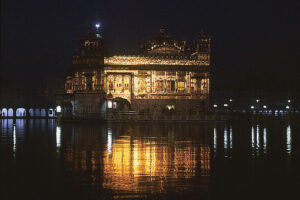
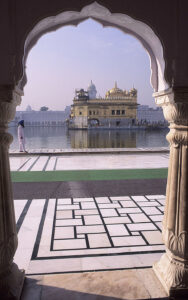

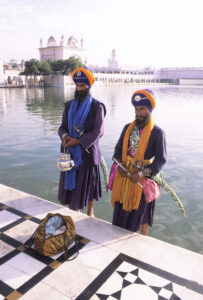
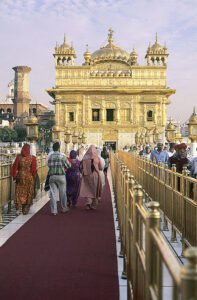
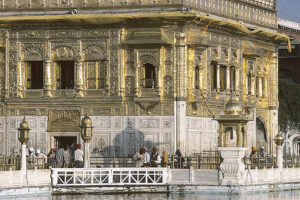
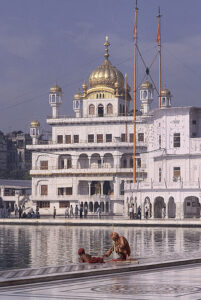
In former days, you could stay as long as you wished, but this was changed, when India was invaded by Western hippies in the 1960s. These hippies, who in general had very little money, grossly exploited this opportunity, staying for weeks. For this reason, the Sikhs had to introduce the new rule of staying maximum three nights in their hostels.
Several sacred jujube trees (Ziziphus mauritiana), believed to possess healing powers, are found on the temple premises. Women, who wish to give birth to a son, attach bits of cloth as an offering to a 475-year-old tree near the main entrance. The species is described in depth on the page Plants: Plants in folklore and poetry.
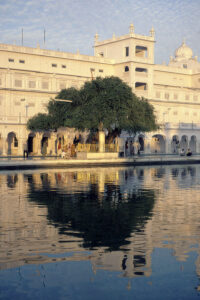
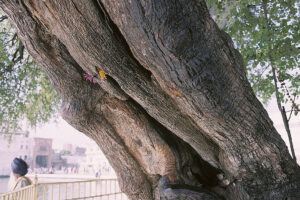
On two occasions, full-scale massacres on Sikhs have taken place in Punjab. A short distance from Hari Mandir, on 13th of April, 1919, c. 20,000 people were demonstrating peacefully against a new law, which permitted British forces, without any cause, to arrest and imprison Indians. Without being provoked, General Dyer and his 150 troops suddenly opened fire. Many demonstrators were shot in the back, when they tried to escape. According to official numbers, 337 men, 46 boys, and a baby were killed, and more than 1,500 wounded. In Europe, numerous governments fumed against the British. The act, however, only enforced the Indian Freedom Movement, and many people followed Mahatma Gandhi’s call for civil disobedience.
In the 1970s, many Sikhs, under the leadership of Jarnail Singh Bhindranwale, wished to pass the so-called Anandpur Resolution, the aim of which was to create an independent Sikh state, Khalistan. In 1982, Bhindranwale and c. 200 of his militant followers moved to a guest house in Hari Mandir, and by 1983, a large number of rebels had taken shelter inside the temple precincts. According to the Indian newspaper The Statesman, a number of light machine guns and semi-automatic rifles were brought into the compound.
On June 1, 1984, Indian Prime Minister Indira Gandhi launched the so-called Operation Blue Star, ordering troops, armed with tanks and other artillery, to storm Hari Mandir and eliminate Bhindranwale and his militant followers. Eventually, the army took control of the temple, but about 200 soldiers and 2,000 others, among these many pilgrims, were killed during a five-day long battle. On June 6, the Indian government declared that the temple had been ‘liberated’. This action, however, was soon revenged. In October 1984, Indira Gandhi was murdered by two of her own Sikh guards, leading to widespread anti-Sikh riots, in which more than 8,000 Sikhs were killed. (Source: en.wikipedia.org/wiki/Operation_Blue_Star)
In 1987, Sikh separatists again occupied Hari Mandir. Prime Minister Rajiv Gandhi launched Operation Black Thunder, but this time Indian authorities managed to persuade the rebels to surrender without confrontations.
In Hari Mandir, a flight of stairs leads up to the Central Sikh Museum, which displays paintings of the 1919-massacre, and macabre photos, depicting people killed during other Sikh rebellions. Many of the temple buildings were heavily damaged by bombings during Operation Blue Star, among these the two Ramgarhia Minarets. They were restored in 1997.
